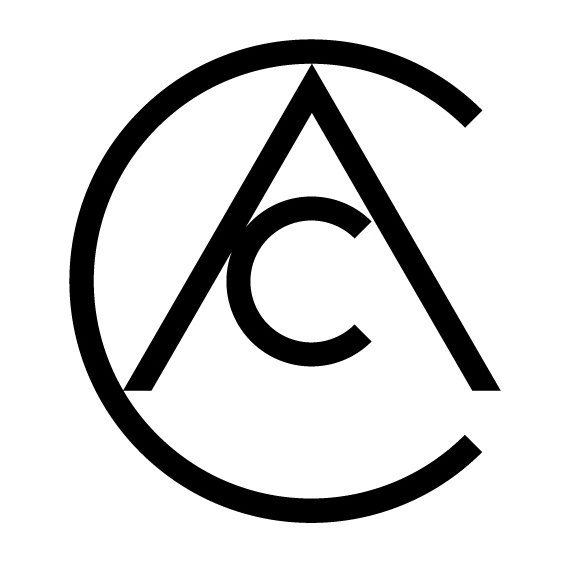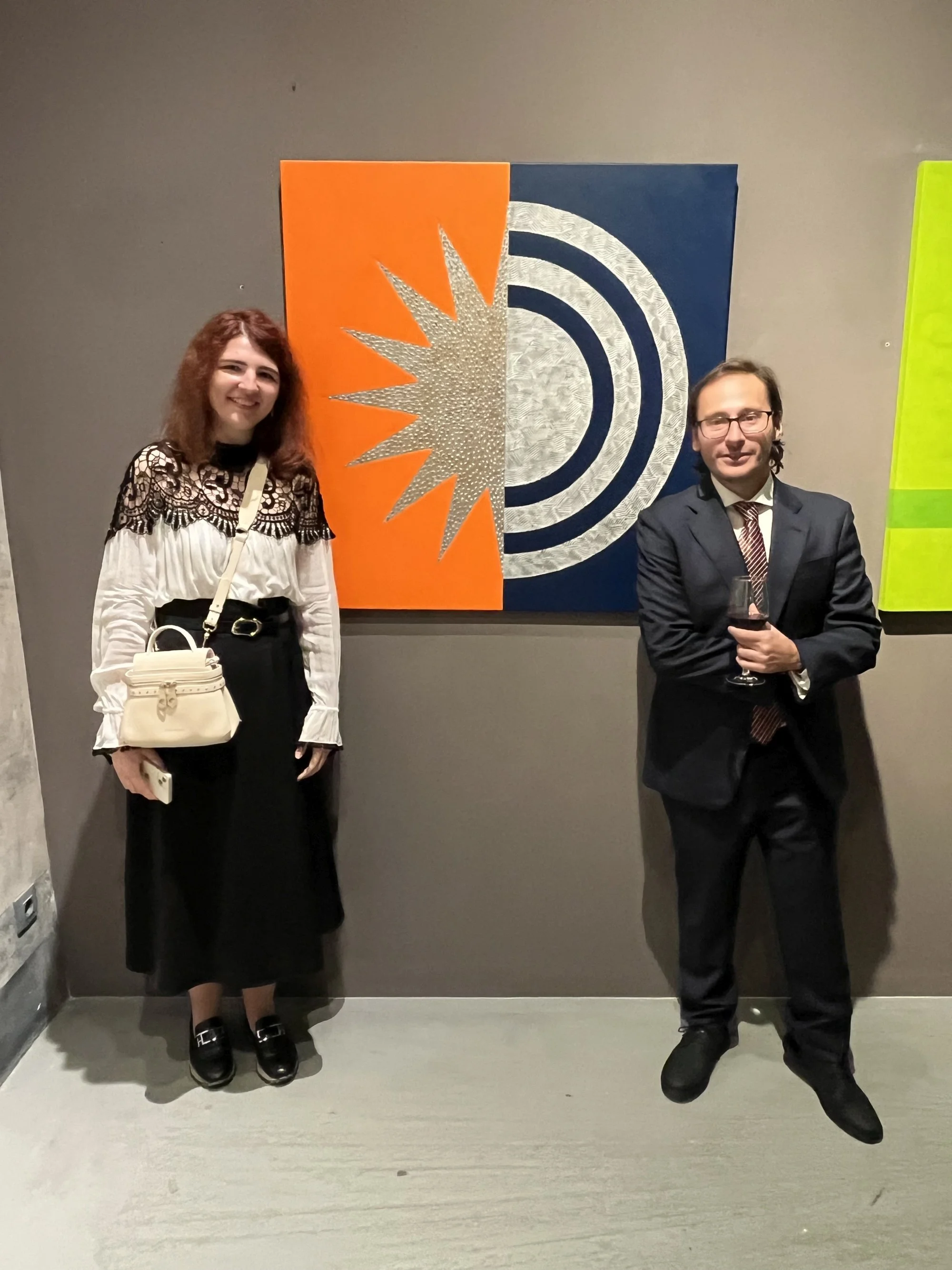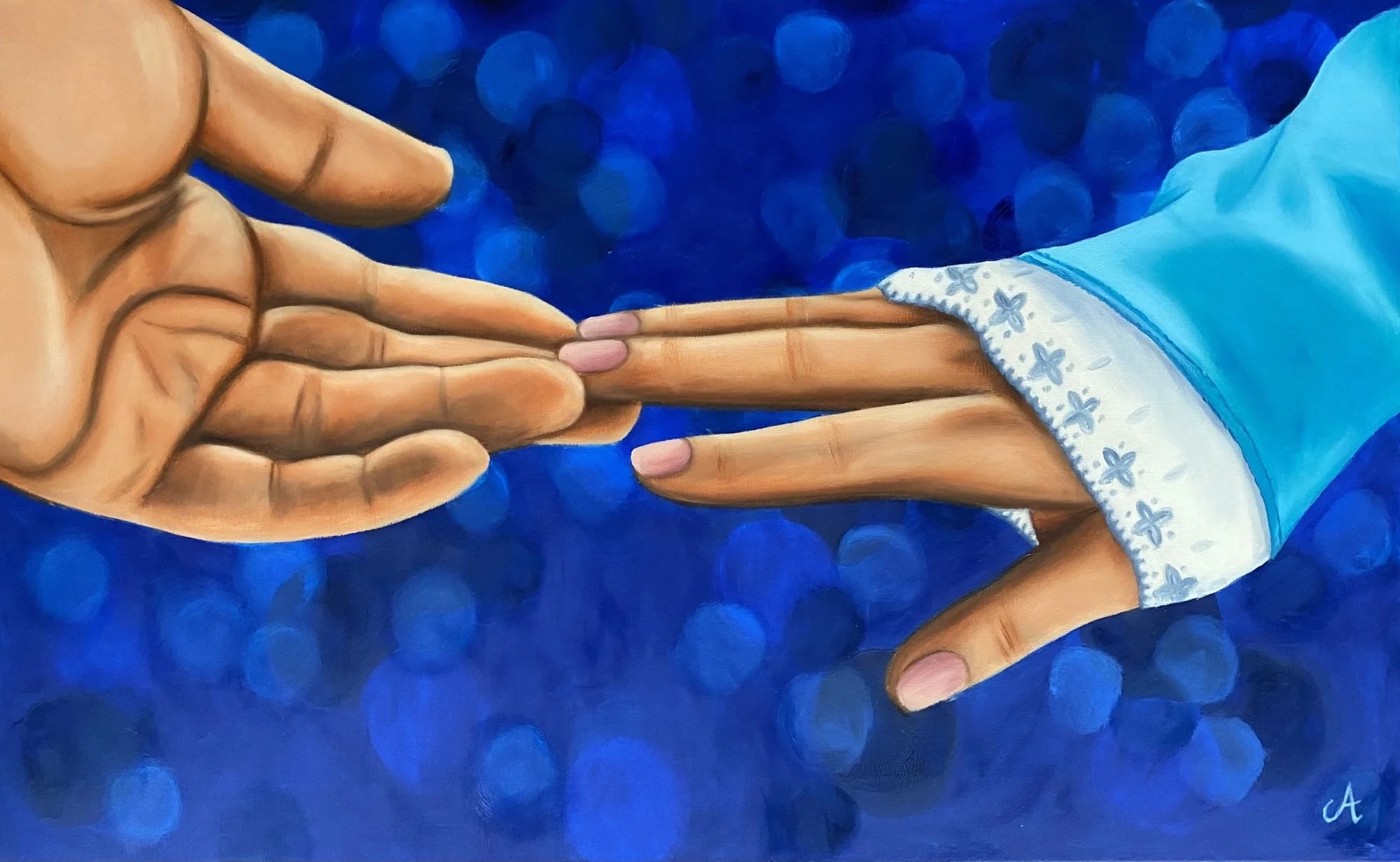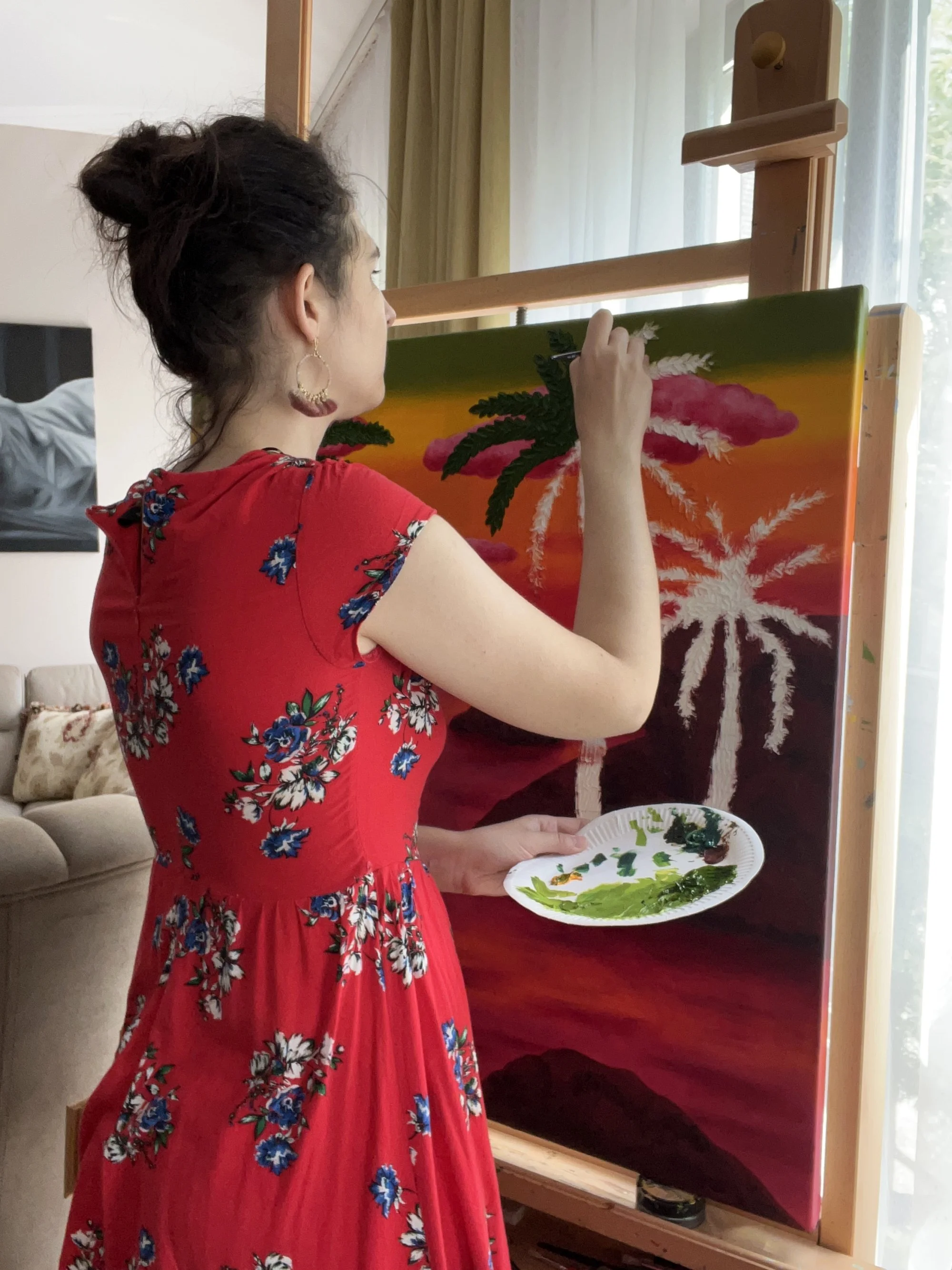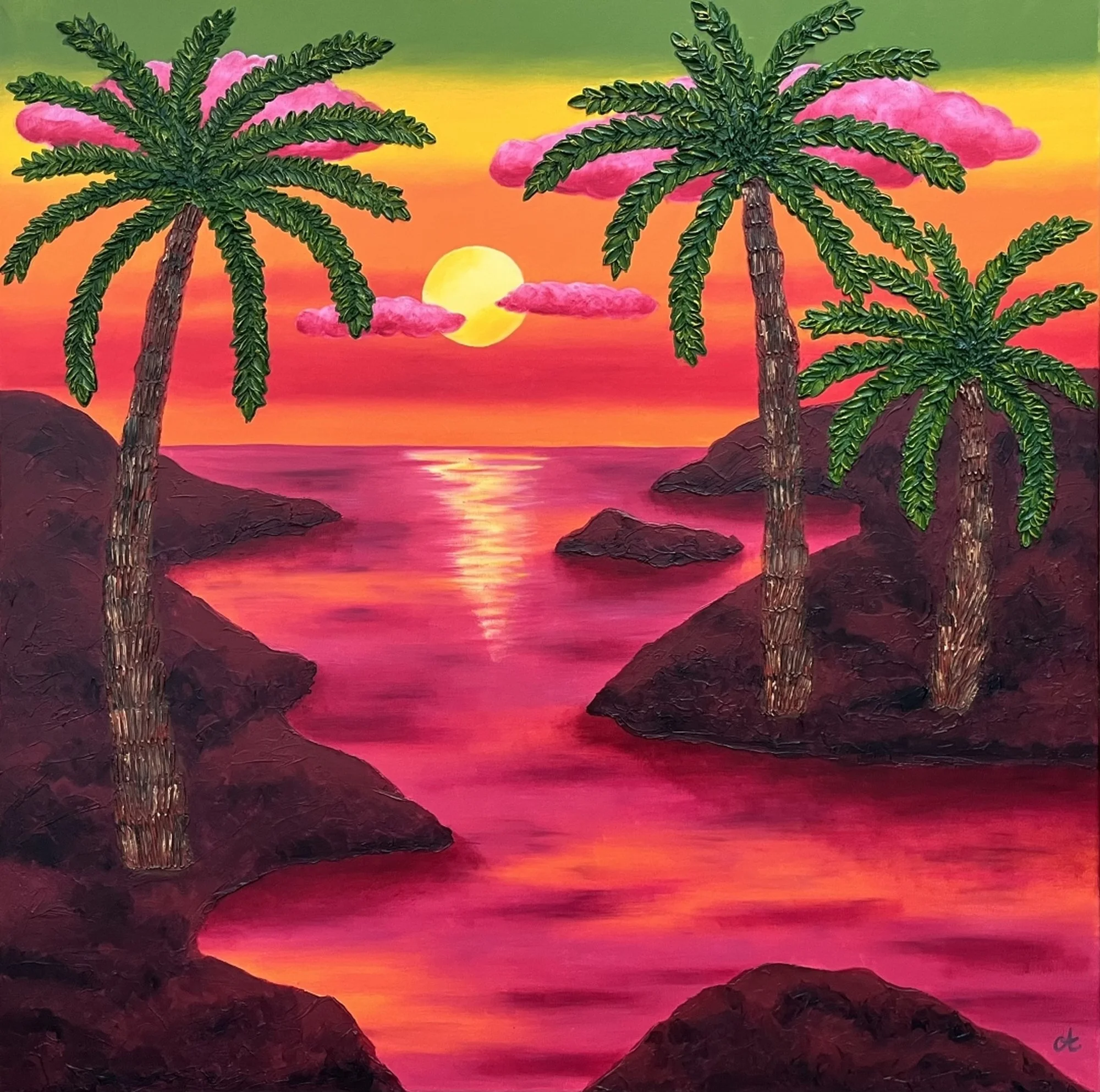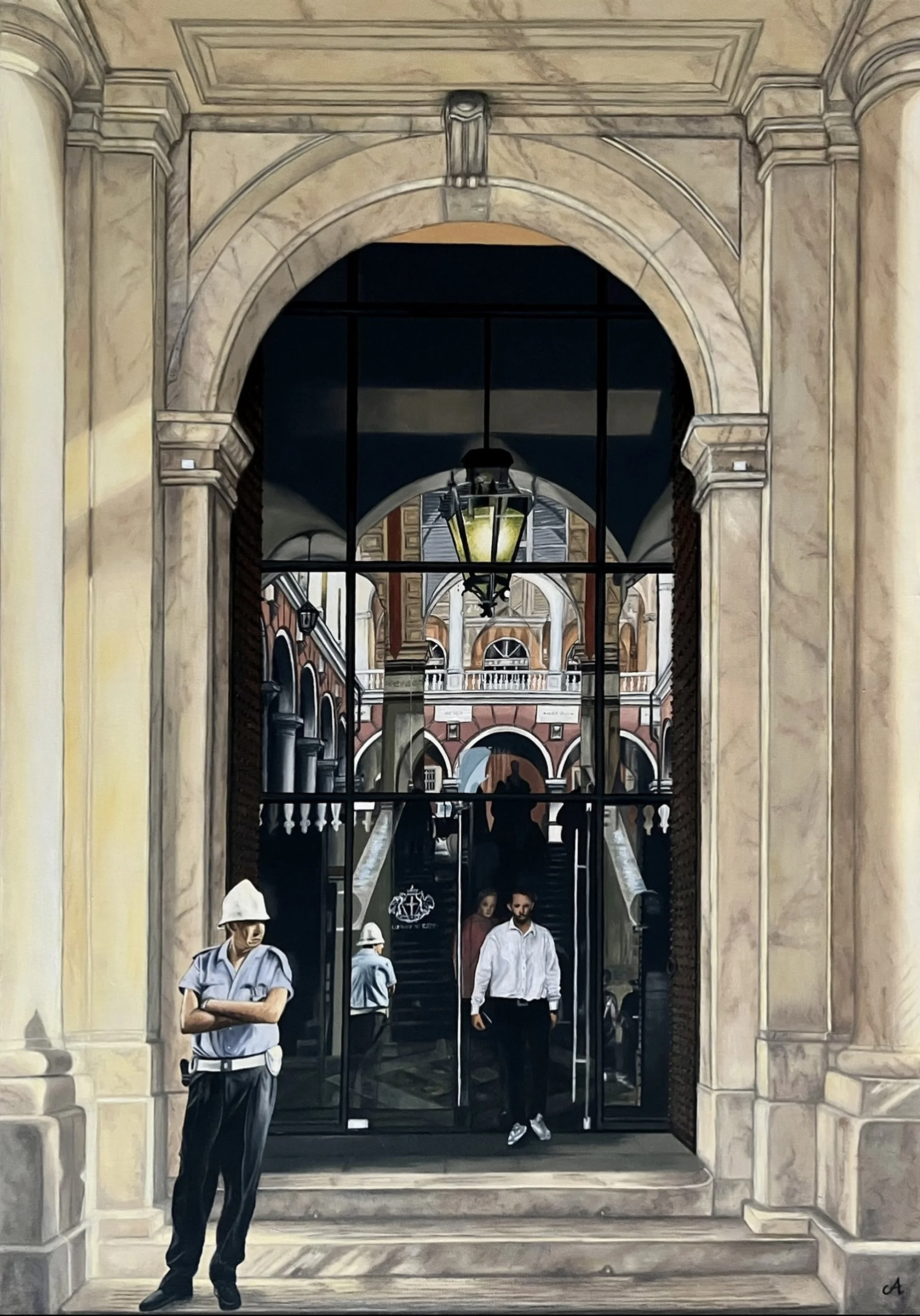Interview with Aleksandra Ciążyńska
Biennale di Sanremo, september 2023
Aleksandra Ciążyńska is an artist who knew from a young age that art would be more than just a hobby for her. She was born in 1987 in Poland. Although she is an economist by profession, she found her true path in painting, which she sees as a way to communicate without words. She honed her skills under the tutelage of Professor Paweł Lewandowski-Palle, achieving success in national and international competitions. Her work has been exhibited not only in Poland but also in Italy, France, Austria, China, United Arab Emirates, the USA, and many other countries. She enjoys diversity of the world and it is from this diversity that she draws inspiration. Today Aleksandra will tell us about her art.
You've been passionate about painting since childhood. Can you share a specific moment or experience from your early years that solidified your love for painting?
Yes, I have loved to paint since I was a child. At first, I painted everything around me: my grandparents' house, my family, the garden, the nearby forest… There were always plenty of crayons at home, but also chestnuts, acorns, pine cones, and flowers, from which I created all sorts of compositions. Crayons were to me what teddy bears were to most children – I took them everywhere. I didn't think then that painting was an activity that I loved doing. I treated art as a natural part of my everyday life.
I remember that in the first grades of primary school, my teacher said that I had talent. She was the first to notice something that had been a fun for me before. Then my parents enrolled me in classes at the Municipal Cultural Center led by Professor Paweł Lewandowski-Palle. I think that was the turning point. That's how my adventure with art began. I attended the professor's classes for many years. I enjoyed them. I tried various painting techniques, but I especially enjoyed painting with paints. Maybe that's why today I prefer to work with oil paints.
As a graduate of the Faculty of Economic Sciences at the University of Warsaw, how do you think your academic background has influenced your approach to art?
Economics is a field based on mathematics. Mathematics shows that there is not just one path to solving a problem. To get the correct result, you can use many methods - they are different, but all lead to the same thing - to the solution of the problem. No matter which one you use, the result is the same. I think that's what I use in painting. I don't follow a single path, I don't always paint the same way, according to a pattern.
Sometimes I start with the background, sometimes with the details, but I always follow the image in my head and strive to achieve that effect on the canvas. Mathematics also teaches patience. Sometimes you make mistakes. In painting too. The most important thing is not to give up, to see where the error is, correct it, and keep painting. Thanks to this skill, I don't get frustrated when something doesn't work out. I try to improve it. If it doesn't work out one day, I try again the next day. Contrary to appearances, painting requires patience, and economics teaches that patience.
Reflecting on your path to becoming an award-winning artist, what were some of the key moments or decisions that led you to where you are today?
The most important thing is not to give up. The beginning of my journey wasn't easy. I kept hearing "no, no, no." Everyone refused me, I didn't receive any replies to my messages. That can be discouraging... I was sad too, but I knew I wanted to paint and that nothing could stop me. The only thing I could do at that time was just to paint. And that's what I did, and after some time I started to shyly send my paintings to competitions. I didn't really believe I could win anything, but I decided that I had nothing to lose by entering.
Imagine my surprise when I received an email from a gallery in New York saying I had won the competition and three of my works had been selected for an exhibition at their gallery. I was very happy and excited. After the exhibition, I was even more fortunate. One of my paintings was awarded by the curator! It gave me wings and motivated me to work even harder. I started to paint even more, I started to publish my work on the internet and on social media. Then everything happened quickly. I started receiving awards for my work.
Now I am very happy that I am appreciated. I don't regret any stages—thanks to the fact that I heard "no" many times in the past, today I am stronger. I also know that art is a specific field—some people like my paintings, others don't, and that's normal. The most important thing is that I can finally show my art to people.
Opening of the „Segnalati” exhibition, Valletta (Malta), october 2023
Biennale di Barcelona, october 2024
Aleksandra's solo exhibition at the Municipal Cultural Centre in Ciechocinek (Poland), february 2025
Winning the "Man and his work" national competition and the Golden Palette in Macedonia are significant achievements. How have these successes impacted your career and confidence as an artist?
My first successes came when I was still a child and were related to classes with Professor Paweł Lewandowski-Palle at the Municipal Cultural Center. These were huge achievements that I was happy about. Nevertheless, those were the years when I was skeptical about my art. I was constantly making changes, repainting. I was never completely satisfied with the results of my work. My hand couldn't keep up with the image I had in my head and which I wanted to transfer to paper. I always said that I could paint a given painting better.
Now I know that it's normal. It takes many hours, consistency, and patience to train your hand to follow the images written in your imagination. Contrary to appearances, painting isn’t easy. Many people imagine that when they follow their passion, everything works out, they don't get tired, and they are always satisfied. The truth is different. Painting is hard physical work—long hours spent at the easel, paint stains on clothes, fatigue, sometimes frustration that something needs to be corrected for the fifth time... this is what everyday life looks like. But it's worth it! Winning competitions certainly increases motivation to continue working. And in those years, they also motivated me to improve with each new painting.
ATiM's Top 60 Masters award ceremony in New York, june 2023
Career award ceremony in Sanremo, september 2023
You view art as a form of non-verbal communication. Can you describe a piece of your work that you feel particularly successful in conveying a message or emotion without words?
Yes, I believe that art is one of the forms of communication with people, communicating without words. Even in ancient times, people used pictographic writing to communicate. All rock drawings, frescoes, and paintings tell us about the lives of people in ancient times, their customs, and the emotions they experienced. I think that the series that shows the most emotion in my paintings is the "Touch" series, which features hands. Gestures can express so much—love, care, respect, help… Very often, words aren't necessary. When I hear from people who view my paintings that they are moved, that my art evokes emotions or memories in them, that they are happy viewing them, that is the greatest joy for me.
„Touch”, oil on canvas, 80x50cm
„Sweet dreams”, oil on canvas, 80x50cm
„Don't go”, oil on canvas, 80x50cm
Your work spans from realism to abstraction. How has your style evolved over the years, and what influences these changes?
The beginning of my artistic adventure was a period of experimentation, both with the subjects of the paintings and with techniques. At that time, I painted everything, from realism to abstraction, using many techniques, from crayons, pastels, various paints to mixed techniques. I also sculpted with clay—figurines, vases, lamps... This period was a bit chaotic, but necessary. I learned a lot during that time. Picasso said: "Learn the rules like a professional, so you can break them like an artist." And that was exactly a learning period for me.
Thanks to this, I realized that oil paints are the best medium for me and that I prefer to paint realistically rather than abstractly. I found my way. Today, I work mainly with oil paints on several series. These are open series. However, I don't close myself off to other techniques—sometimes I make exceptions and choose a different medium, but the core of my art is realistic oil painting. I have a lot of ideas in my head for further series in this technique, so currently, the changes concern more the subjects of the works than the techniques.
You mention a love for playing with colors and textures. Can you walk us through your process of selecting and combining colors and textures in a new piece?
I love colors. Without colors, life would be boring. I have always been inspired by the world—its diversity and multi-colored nature. Life is a kaleidoscope of colors! That is why my paintings are very colorful. I am not afraid to combine colors that would seem to not fit together at first glance. When I start a painting, I choose a few tubes of paints that I combine with each other. I never work with the entire color palette—it is always the colors I have chosen, the colors that I want to see on a given painting. That's a maximum of 10 colors per painting.
Of course, I combine them with each other, so there are more colors on the finished painting. When it comes to textures, I like to combine acrylic structural paste with oil paints. First, I apply the paste to the canvas—this creates a structure, and then I paint it with the oils. I used this technique more often in the past, but today it is only one series—“Secret Gardens.” All the paintings (for now there are 10 works, although the series is open) represent nature and are, of course, very colorful.
While working on the painting „Secret Garden VII”
„Secret garden VII”, mix media on canvas, 90x90cm
Your paintings cover a wide range of topics. Is there a subject or theme you find yourself returning to often? If so, why?
I love diversity. The world is an endless source of inspiration for me. It's so beautiful and colorful that I couldn't limit myself to just one subject. I'm fascinated by everything about life—I look at people, their traditions, the places they live in, nature, cities… I would like to show all of this in my paintings. „Flower meadows”, „Venetian masks”, „Touch”… these are just some of the series I paint.
Recently, I have been working on a new series called "Invitations." I want to show in it underappreciated fragments of our everyday live, places that we pass by every day without paying any attention to them. It all started with a trip to Genova. I saw the entrance to the town hall, guarded by a guard. The entrance was beautiful, but no one paid any attention to it. Tourists passed by the place without thinking and petitioners came and went without looking at their surrounding. I took a photo and knew I had to paint it. It was the same with one of Genova's tunnels and the entrance to the Rome metro (specifically at the Spagna station). A lot of people go there every day – residents, tourists, everyone is in a hurry and doesn’t notice that the entrance is unique – it’s a mosaic imitation on the walls, the lights – it’s really impressive!
This was the beginning of a series I'm still working on, and I'm constantly collecting these "invitations"—entrances, gates, tunnels, doors—anything that leads to a world. I’d like everyone who looks at my painting to want to go inside, to see more. This is a series that has truly captivated me, I’m spending the most time on it now. Nevertheless, I don't assume that I’ll find other inspirations in the future and that I’ll paint something else… But that's the future. The present belongs to the "Invitations."
„Invitation- Genova”, oil on canvas, 70x100cm
„Invitation- Genova 2”, oil on canvas, 70x100cm
„Invitation- M Spagna Rome”, oil on canvas, 70x100cm
In your artist statement, you mention that art is an eternal learning process. What are some recent learnings or discoveries you've made through your art?
Yes, art is an eternal learning that allows you to pay attention to things that are imperceptible to others. Discover the beauty of the world around us, the uniqueness of forms, colors and shapes that accompany us imperceptibly every day. We walk the same streets every day, pass the same buildings, yet they don't look the same every day. When the sun shines, colors are very intense and shadows are very visible; when there's fog, the scenery looks completely different—everything is blurred and the world put pastel colors; at night, the moonlight and streetlights create a romantic atmosphere; in the rain, everything is beautifully reflected in the puddles, creating a mirror effect.
I won't even mention the imagination, where we have the images of a given place stored. It's fascinating and allows us to see the world in a completely different way, while also teaching us that everything is subjective. Each of us has our own ideas about different topics. And a single subject can be presented in many ways. After all these years of painting, I've learned to appreciate the world around me and to use my imagination. I often transfer the images I have in my head to canvas. My technique has also changed—I think it's improved. My choice of colors and subjects is constantly evolving.
Although I currently work most often with oils, I still enjoy experimenting. From time to time, I introduce changes, doing something I've never done before. A good example is the "Venetian Masks" series. Most of them are oil paintings, but recently I made three 3D masks—I used papier-mâché, buttons, tissue paper, ribbon, and beads, and attached everything to the canvas. The effect is three-dimensional.
Generally, I believe that to grow, you need to change something from time to time, go beyond your comfort zone and try something new. Then you are even more willing to return to your tried and tested techniques and topics. The world is too diverse and colorful to keep doing the same thing. A lot is lost because of this. You shouldn't close yourself off to something you don't know. Experimenting is an integral part of learning and development.
You describe painting as a gift that you're glad to share with the world. What do you hope viewers take away from your work, and how do you wish to impact the broader art community?
"Happy are those who see beauty in ordinary places, where others see nothing! Everything is beautiful, you just need to know how to look carefully" observed Pissarro. Matisse, on the other hand, said: "I strive for balance and purity, for an art that does not sow fear and confusion; so that a tired, tormented, and besieged person can experience a bit of peace and quiet in front of my paintings." I would like my painting to be perceived in this way. I am more interested in the subject of the painting than in its form.
I want all viewers to feel positive emotions when looking at my works and to think: the world is really beautiful! I would like to tell them: look at how much beauty is around, fulfill your dreams and be happy, use the time given to you in the best possible way, appreciate everyday life! This is my main goal. Of course, it won't always be easy, but it's worth it!
At work with oil pastels (Any place is good for painting. When I am tired, I like to sit on the floor and paint)
